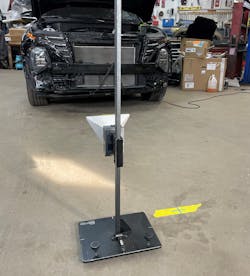Content brought to you by ABRN. To subscribe click here.
What you will learn:
•Secured gateways require permissive entry
•Having the proper scan tool may not be enough
•Registering scan tools is now a necessity
I was recently called to a shop that replaced a damaged front radar Control Module on a 2022 Hyundai Tucson that was involved in a front-end collision (Figure 1).
I had instructed the shop to leave off the front bumper because on most Hyundai vehicles there is no access to the front of the radar assembly to adjust the vertical and horizontal screws, unlike most other manufacturers. It just does not make sense to me, but it is the choice of engineering when they design these vehicles without service being part of the thought process. Many manufacturers will provide a trap door cover or a removable bezel that hides the radar unit, or they may simply give you access behind & below the housing to access the adjusting screws.
When I arrived at the shop, I noticed the message on the instrument cluster, “Check Forward Safety System” (Figure 2), so I proceeded to hook up my scan tool to access my Advanced Driver Assistance System software to scan the system for faults. The other systems were all free of trouble codes, but the Autonomous Emergency Braking Module had a code C162078 for Alignment Failed (Figure 3), so this vehicle needed calibrating of the front radar system. The ADAS software is thoroughly structured with step-by-step instructions on how to set up the calibration reflector stand, and it is all about knowing how to mark the proper spot in front of the vehicle to place the stand.
I will usually find the best level floor space facing out a doorway so that I am guaranteed to have no objects interfering with the radar beam as it looks for my reflector target. The vehicle would have to be plumb bobbed from the front and rear vehicle emblems down to the floor with a marked position, followed by placing a laser target at the rear floor marking to aid in shooting a laser directly thru both marks from the front of the vehicle creating a centerline under the vehicle. I like to use dual lasers to speed up the process because some of these vehicles do not locate the radar unit front and center of the vehicle. I set up a laser grid on the floor to make sure my grid lines were equidistant from vehicle centerline to the center of the radar housing (Figure 4).
The next step is to place the target on the corner of the grid facing the radar unit and moving the target cone down to a point where the cone’s internal laser hits the center of the radar housing (Figure 5. See above). At this point, you are ready to command the radar unit to aim at the target to see the actual vertical and horizontal measurements. Then it is just a matter of turning adjustment screws on the radar housing to get everything into specification. It sounds easy enough if every step is followed through, and then you get a screen that makes you scratch your head that says, “Security Access not Permitted” (Figure 6). So, then I thought to myself, ‘Is this one of those vehicles where The Car Spy Study Act of 2017 was implemented, and our government has finally directed the National Highway Traffic Safety Administration to ask all manufacturers to voluntarily start locking the 2022 vehicles with secured gateways to prevent bidirectional commands or is this an issue with my tool?’ I quickly backed out of the ADAS software and went into the ABS module to do a simple Steering Angle Sensor calibration to see if it was just a bug in the ADAS software or whether this vehicle was indeed in cybersecurity lockdown, and I was unable to perform that task as well.
Luckily for me, I had the factory Hyundai GDS Scan tool. So, at this point, I moved to a backup plan. The Hyundai GDS had no issues logging into the Hyundai server, which allowed me to access the Sensor Alignment procedure (Figure 7). There was a criteria list to make sure the tires were properly inflated, vehicle alignment was correct, shop floor was level, and the wheels were pointed straight ahead. Then I was instructed to choose a distance between 39-149 inches, so I chose 75 inches as a comfortable distance (Figure 8). As I commanded the radar unit to hit the target, the final screen showed a successful calibration reading of -0.97 Vertical and +0.66 Horizontal and I was done (Figure 9). I usually like to see a +/- of 1.0 degrees on a Hyundai, but keep in mind that each manufacturer specification is different. Honda requires +/- 0.1 Vertical while Nissan may require +/- 2.5 Vertical on some of their models.
Look for 2022 model year vehicles to have more robust cybersecurity
This vehicle threw me a curveball, because we are now at a point in the automotive industry of not knowing which manufacturers are securing their vehicles for 2022. I know that Chrysler started in 2018 and Nissan started in 2020 on their Sentra Models. The way it is supposed to work for aftermarket scan tools is to go to AutoAuth.com and register your shop, technicians, and your scan tools that have access to the internet and pay the yearly fee. Once registered, you would be allowed to unlock the Secured gateways on vehicles that have them to perform bidirectional tasks such as clearing codes or performing functional procedures with the scan tool. This is all great if you are working on a Chrysler product, but Nissan has yet to allow Autoauth to unlock their vehicles because it is not a mandate to do so; it’s only on a voluntary basis.
I have made a large investment in factory tools, and I have them for the most common manufacturers (which I see on a weekly basis) except for Volvo, Porsche, and Mercedes. It comes down to how much you see of the vehicles and how much you can afford to pay for the daily/monthly/yearly subscriptions. I am sure at some point; all manufacturers will be combined on one site that will make the aftermarket scan tool user’s life easier. The aftermarket tools will not necessarily warn you on every vehicle manufacturer if there is a secured gateway but will instead give you an error message like “No Communication” when you try to perform a task, and it just creates confusion.
I was recently told that on some of the new 2022 Mercedes vehicles, you will need to log in with a Mercedes-licensed software subscription using “Facial Recognition” on their factory tool. It sounds crazy, but think about the networks on vehicles today that were never encrypted or secured from satellite services that came with these vehicles with the use of onboard telematics. Hacking cars from afar is a safety and security issue when you simply Bluetooth your cell phone to your vehicle, your phone can be hacked by someone entering your vehicle network through the telematics control module.
With the introduction of Advanced Driver Assist Systems, you now have modules that interact with one another to control the electronic steering, advanced braking system, and the electronic throttle motors that control vehicle steering/braking/acceleration at any given time when commanded by these complex onboard systems for the safety of the driver and its passengers. The new fear is someone hacking the vehicles to put drivers & passengers in harm’s way. It all sounds like science fiction taking place, but this is a whole new world on vehicle technology as we push toward fully driverless vehicles. And before we can make that happen, it will be safety first. So, look at 2022 as the start of implementing more robust security for vehicles, and talk to your state representatives about keeping the Right to Repair in the hands of aftermarket scan tool users. I hope this article has made you more aware of what is here now and what is to come to the future of our automotive industry.
About the Author

John Anello
Owner and operator of Auto Tech on Wheels
John Anello is the owner and operator of Auto Tech on Wheels, established in 1991 in northern New Jersey. He provides technical assistance and remote reprogramming with 21 factory PC-based scan tools. Driven by a passion for cars, John's business now services roughly 1,700 shops.
